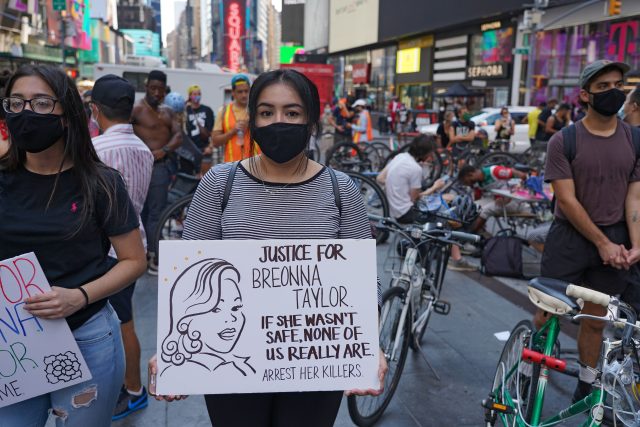On March 13, the day the New-York Historical Society closed its doors to the public, Rebecca Klassen, an associate curator for material culture, was scrolling through Instagram when something caught her eye. A friend from the gym had posted an image to her story of a massive bottle of Purell. At the time, store shelves across the five boroughs were already bereft of disinfectants. The picture, Klassen says, was reminiscent of “some kind of night run in the frantic search for sanitizer.” It was captioned “liquid gold.”
The post prompted Klassen to send two messages. The first was an email to Margaret K. Hofer, the Historical Societys museum director and vice president, asking whether they ought to start collecting items from New Yorkers related to the coronavirus pandemic. The second was a DM in response to her friends story. “Hey, can I have that when youre done?” she asked. “I want to add it to our museum collection.”

People tend to think of archives as massive troves that are compiled long after an era has ended or someone has died. But when it comes to COVID-19, archivists, curators, and librarians nationwide are assembling the record of how the pandemic is impacting their communities in real time, collecting everything from makeshift masks to journal entries to protest signs. Their mandate is both urgent and sweeping: Gather items from a broad swath of residents that, viewed together, tell the story of a particular regions collective experience of coronavirus. “A lot can be lost over time,” says Ayshea Khan, the Asian American community archivist at the Austin History Center. “Memories can shift, things can be thrown away. Its important to archive present moments when they happen, as much as we can, to ensure an accurate representation of our citys history.”
COVID-19 isnt just impacting what is being archived, its also impacting how. Before the lockdowns, staffers at libraries and history centers would organize drives for donations, attend events to look for discarded physical artifacts, and collaborate with local memory keepers to get the goods. “Normally, with our rapid-response collecting, we are out there on the street,” Hofer says. These days, though, archivists have had to get creative. Many organizations have built online portals for volunteers to submit digital files—audio, photos, poetry, you name it. Some collections are more selective than others, but when the archive being formed is largely digital and donor-directed, there can be reason to hold onto almost anything that falls within the scope of the project. “Its a comprehensive set of resources,” says Madeline Moya, the media archivist at the Austin History Center. “We dont know what a researcher will come in looking for at any given time.” Sorting through these submissions will be a huge amount of work, but thats a problem for a later date. For now, the goal is to collect as quickly and widely as possible.

At the Austin History Center, collecting for what theyre calling the “COVID-19 Files” began on Facebook, where Marina Islas, the AHCs Latinx community archivist, posed a question: “We are living through a historic moment. How is that affecting your life?” Meanwhile, Khan emailed organizers and groups she had worked with previously to gather their experiences and participated in a virtual town hall addressing anti-Asian racism related to COVID-19 in the area. Moya reached out to a photographer she knew who works with Austins homeless population about donating recent works. Audiovisual archivist Afsheen Nomai, who has been active in the r/Austin subreddit for a decade, archived the posts of a user whose daily coronavirus charts had developed a loyal following.
In New York, Klassen has made ample use of Instagram. Shes messaged friends about donating items, like the supersized Purell bottle, but says the app is also a way to pick up on trends even outside the boundaries of her own filter bubble. “Seeing something shared multiple times or visually through pictures elevates its importance and its collection-worthiness,” she says. In the early months of the pandemic, she noticed people posting photos of burgeoning miniature herb gardens and handwritten notes of thanks from local businesses and sought out those images for the collection. Then, when Black Lives Matter protests began in late May, the app became her way to keep track of New York Citys many grassroots organizing efforts and to follow up with participants about donating signs or telling their stories. The New-York Historical Societys collecting program is among those that are now gathering materials from both the pandemic and the protests. “Some people see pandemic collecting and Black Lives Matter collecting as two separate streams,” Klassen says. “On the one hand they are, but theyre also very much intertwined.”
Not just that, but many issues at the heart of both are central to the work of archiving. Decisions around who gets to be remembered and whose voice should be listened to have been instrumental in perpetuating racism for as long as there have been history books. Done right, community collecting can be an opportunity to redefine what kinds of stories, artifacts, and experiences are being prioritized and preserved.

Scholars of prior pandemics know first-hand that this is imperative. Nancy K. Bristow, the chair of the University of Puget Sounds history department and author of American Pandemic: The Lost Worlds of the 1918 Influenza Epidemic, began her research in the hopes of understanding the experiences of her working-class great-grandparents in Pittsburgh. But fRead More – Source
[contf] [contfnew] 
arstechnica
[contfnewc] [contfnewc]







